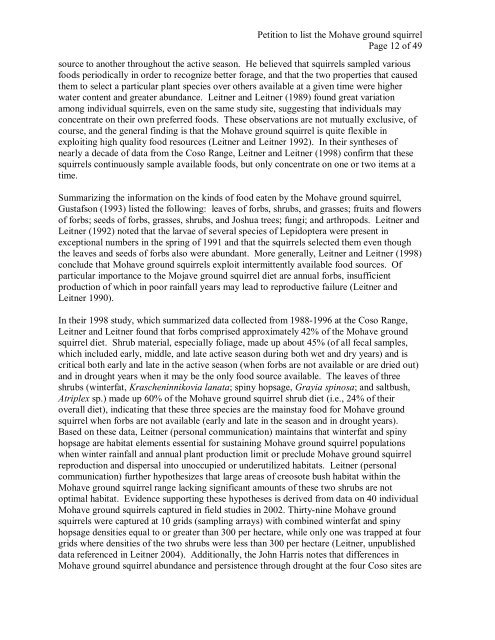Petition to list the Mohave Ground Squirrel - Defenders of Wildlife
Petition to list the Mohave Ground Squirrel - Defenders of Wildlife
Petition to list the Mohave Ground Squirrel - Defenders of Wildlife
Create successful ePaper yourself
Turn your PDF publications into a flip-book with our unique Google optimized e-Paper software.
<strong>Petition</strong> <strong>to</strong> <strong>list</strong> <strong>the</strong> <strong>Mohave</strong> ground squirrel<br />
Page 12 <strong>of</strong> 49<br />
source <strong>to</strong> ano<strong>the</strong>r throughout <strong>the</strong> active season. He believed that squirrels sampled various<br />
foods periodically in order <strong>to</strong> recognize better forage, and that <strong>the</strong> two properties that caused<br />
<strong>the</strong>m <strong>to</strong> select a particular plant species over o<strong>the</strong>rs available at a given time were higher<br />
water content and greater abundance. Leitner and Leitner (1989) found great variation<br />
among individual squirrels, even on <strong>the</strong> same study site, suggesting that individuals may<br />
concentrate on <strong>the</strong>ir own preferred foods. These observations are not mutually exclusive, <strong>of</strong><br />
course, and <strong>the</strong> general finding is that <strong>the</strong> <strong>Mohave</strong> ground squirrel is quite flexible in<br />
exploiting high quality food resources (Leitner and Leitner 1992). In <strong>the</strong>ir syn<strong>the</strong>ses <strong>of</strong><br />
nearly a decade <strong>of</strong> data from <strong>the</strong> Coso Range, Leitner and Leitner (1998) confirm that <strong>the</strong>se<br />
squirrels continuously sample available foods, but only concentrate on one or two items at a<br />
time.<br />
Summarizing <strong>the</strong> information on <strong>the</strong> kinds <strong>of</strong> food eaten by <strong>the</strong> <strong>Mohave</strong> ground squirrel,<br />
Gustafson (1993) <strong>list</strong>ed <strong>the</strong> following: leaves <strong>of</strong> forbs, shrubs, and grasses; fruits and flowers<br />
<strong>of</strong> forbs; seeds <strong>of</strong> forbs, grasses, shrubs, and Joshua trees; fungi; and arthropods. Leitner and<br />
Leitner (1992) noted that <strong>the</strong> larvae <strong>of</strong> several species <strong>of</strong> Lepidoptera were present in<br />
exceptional numbers in <strong>the</strong> spring <strong>of</strong> 1991 and that <strong>the</strong> squirrels selected <strong>the</strong>m even though<br />
<strong>the</strong> leaves and seeds <strong>of</strong> forbs also were abundant. More generally, Leitner and Leitner (1998)<br />
conclude that <strong>Mohave</strong> ground squirrels exploit intermittently available food sources. Of<br />
particular importance <strong>to</strong> <strong>the</strong> Mojave ground squirrel diet are annual forbs, insufficient<br />
production <strong>of</strong> which in poor rainfall years may lead <strong>to</strong> reproductive failure (Leitner and<br />
Leitner 1990).<br />
In <strong>the</strong>ir 1998 study, which summarized data collected from 1988-1996 at <strong>the</strong> Coso Range,<br />
Leitner and Leitner found that forbs comprised approximately 42% <strong>of</strong> <strong>the</strong> <strong>Mohave</strong> ground<br />
squirrel diet. Shrub material, especially foliage, made up about 45% (<strong>of</strong> all fecal samples,<br />
which included early, middle, and late active season during both wet and dry years) and is<br />
critical both early and late in <strong>the</strong> active season (when forbs are not available or are dried out)<br />
and in drought years when it may be <strong>the</strong> only food source available. The leaves <strong>of</strong> three<br />
shrubs (winterfat, Krascheninnikovia lanata; spiny hopsage, Grayia spinosa; and saltbush,<br />
Atriplex sp.) made up 60% <strong>of</strong> <strong>the</strong> <strong>Mohave</strong> ground squirrel shrub diet (i.e., 24% <strong>of</strong> <strong>the</strong>ir<br />
overall diet), indicating that <strong>the</strong>se three species are <strong>the</strong> mainstay food for <strong>Mohave</strong> ground<br />
squirrel when forbs are not available (early and late in <strong>the</strong> season and in drought years).<br />
Based on <strong>the</strong>se data, Leitner (personal communication) maintains that winterfat and spiny<br />
hopsage are habitat elements essential for sustaining <strong>Mohave</strong> ground squirrel populations<br />
when winter rainfall and annual plant production limit or preclude <strong>Mohave</strong> ground squirrel<br />
reproduction and dispersal in<strong>to</strong> unoccupied or underutilized habitats. Leitner (personal<br />
communication) fur<strong>the</strong>r hypo<strong>the</strong>sizes that large areas <strong>of</strong> creosote bush habitat within <strong>the</strong><br />
<strong>Mohave</strong> ground squirrel range lacking significant amounts <strong>of</strong> <strong>the</strong>se two shrubs are not<br />
optimal habitat. Evidence supporting <strong>the</strong>se hypo<strong>the</strong>ses is derived from data on 40 individual<br />
<strong>Mohave</strong> ground squirrels captured in field studies in 2002. Thirty-nine <strong>Mohave</strong> ground<br />
squirrels were captured at 10 grids (sampling arrays) with combined winterfat and spiny<br />
hopsage densities equal <strong>to</strong> or greater than 300 per hectare, while only one was trapped at four<br />
grids where densities <strong>of</strong> <strong>the</strong> two shrubs were less than 300 per hectare (Leitner, unpublished<br />
data referenced in Leitner 2004). Additionally, <strong>the</strong> John Harris notes that differences in<br />
<strong>Mohave</strong> ground squirrel abundance and persistence through drought at <strong>the</strong> four Coso sites are
















